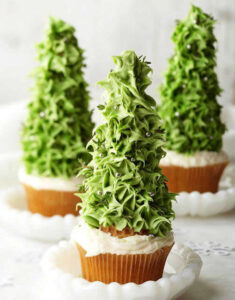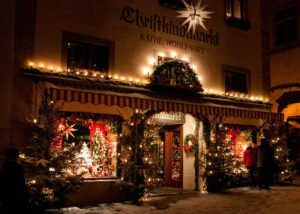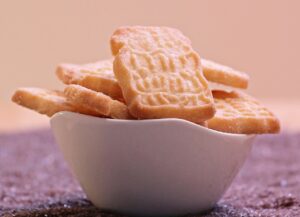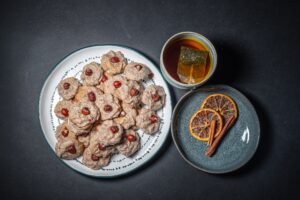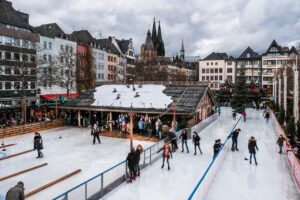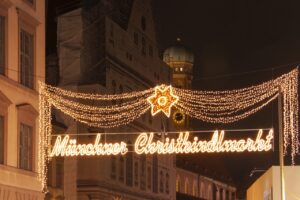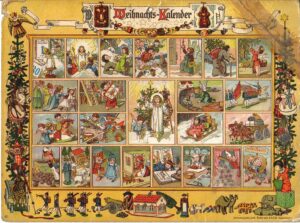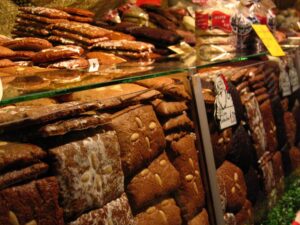Ingredients:*-*-*-*-*-*-*-*-*-*-*-*-*-*-*-*-*-*-*-*-*-* 150 g butter, softened150 g caster sugar3 eggs, beaten150 g self-raising flour, sifted1 tsp vanilla extract1 tbsp milk For the frosting 200 g butter, at room temperature250 g icing sugar1 tsp vanilla extract1 tbsp milkgreen food coloring To decorate: silver balls, sugar … [Read more...]
Discovering Joy and Tradition: A Visit to the German Christmas Museum
Germany, renowned for its magical Christmas markets and deep-rooted holiday traditions, is home to a gem that encapsulates the spirit of the season: the German Christmas Museum. Nestled in the picturesque town of Rothenburg ob der Tauber, this museum is not just a repository of holiday artifacts but a portal into the heart of Christmas … [Read more...]
Spekulatius (German Spiced Biscuits): A Traditional Delight
Spekulatius, a name synonymous with the festive spirit and cozy winter evenings, refers to the traditional German spiced biscuits that have been a culinary staple for centuries. Originating from the Rhineland and Westphalia regions of Germany, these delightful treats are not only a staple during the Christmas season but have also garnered global … [Read more...]
Haselnussmakronen (German Hazelnut Macaroons): A Delightful Treat from Germany
The aroma of freshly baked Haselnussmakronen, or German hazelnut macaroons, is enough to evoke a sense of warmth and nostalgia. These delightful treats, not to be confused with French macarons, are a staple in German baking, particularly during the festive season. Rich in flavor and simple in preparation, Haselnussmakronen embody the essence of … [Read more...]
Exploring the Magic of the Cologne Christmas Market: A Festive Journey
As the festive season approaches, the city of Cologne transforms into a winter wonderland, with its renowned Christmas Market taking center stage. This article explores the magical allure of the Cologne Christmas Market, a place where traditional German holiday charm, unique gift ideas, and delightful culinary treats come together to create an … [Read more...]
The Magic of the Munich Christmas Market: A Festive Wonderland
As the festive season approaches, the Munich Christmas Market, or "Christkindlmarkt," stands out as a beacon of holiday cheer and tradition. Nestled in the heart of Bavaria, Germany, this market is not just a destination; it's an immersive experience that captures the essence of Christmas. In this article, we'll explore the magic of the Munich … [Read more...]
Exploring the Rich History of Advent Calendars in Germany
The tradition of counting down to Christmas with an Advent calendar is a cherished ritual for many, especially in Germany where it originated. This article explores the rich history of Advent calendars in Germany, tracing their evolution from simple chalk lines to the elaborate and diverse forms we see today. Understanding the origins and cultural … [Read more...]
Nuremberg Christmas Market: A Timeless Winter Wonderland
The Nuremberg Christmas Market, known locally as the Christkindlesmarkt, is a beacon of festive spirit and one of the oldest and most famous Christmas markets in the world. This article delves into the enchanting atmosphere of the market, exploring its history, unique offerings, and providing essential tips for visitors. The Historical Charm of … [Read more...]
Nuremberg Lebkuchen: A Traditional German Treat
The city of Nuremberg, nestled in the heart of Bavaria, Germany, is renowned for many things, but perhaps none so delightful as its Lebkuchen. These traditional German gingerbread cookies, known for their rich spices and intricate designs, have been a cornerstone of Nuremberg's culinary culture for centuries. Historical Roots of Lebkuchen The … [Read more...]
Lebkuchen – German Gingerbread Recipe
Lebkuchen, often hailed as Germany's answer to gingerbread, is a traditional treat that encapsulates the heartwarming essence of German baking. This spiced, slightly sweet confection is a staple during the Christmas season, but its delightful flavor and ease of preparation make it a year-round favorite for many. In this comprehensive guide, we'll … [Read more...]
- 1
- 2
- 3
- 4
- Next Page »
